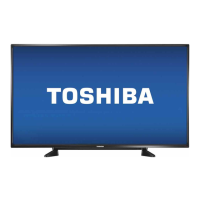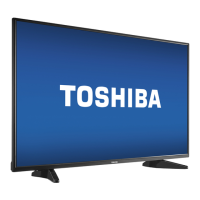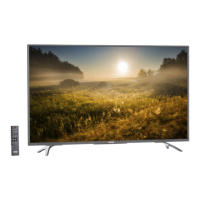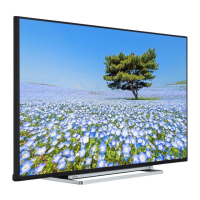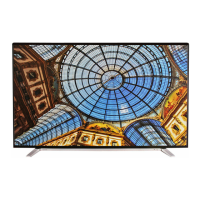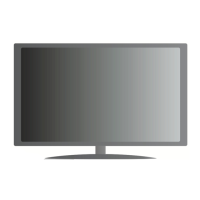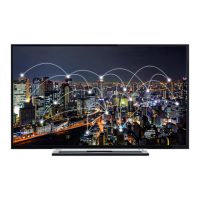
Do you have a question about the Toshiba 43L3753DB and is the answer not in the manual?
| Screen shape | Flat |
|---|---|
| Response time | - ms |
| Display diagonal | 43 \ |
| Display brightness | - cd/m² |
| Display technology | LED |
| Native aspect ratio | 16:9 |
| LED backlighting type | Direct-LED |
| Contrast ratio (typical) | - |
| Display diagonal (metric) | 109 cm |
| Supported graphics resolutions | 1920 x 1080 (HD 1080) |
| Motion interpolation technology | PQI (Picture Quality Index) 700 |
| 3D | No |
| Luminance | 72 % |
| Annual energy consumption | 78 kWh |
| Channels quantity (DVB-C) | 800 |
| Channels quantity (DVB-S2) | 10000 |
| Channels quantity (analog signal) | 200 |
| Tuner type | Analog & digital |
| Digital signal format system | DVB-C, DVB-S2, DVB-T2 |
| Video apps | Netflix, YouTube |
| Hybrid Broadcast Broadband TV (HbbTV) version | 1.5 |
| Sound modes | Classic, Flat, Movie, Music, Speech |
| Audio decoders | DTS, DTS TruSurround, DTS-HD |
| RMS rated power | 16 W |
| Number of speakers | 2 |
| Equalizer bands quantity | 5 |
| AC input voltage | 220 - 240 V |
| AC input frequency | 50 Hz |
| Power consumption (standby) | 0.5 W |
| Power consumption (typical) | 54 W |
| Audio formats supported | MP3, WAV, WMA |
| Image formats supported | BMP, JPEG, JPG, PNG |
| Video formats supported | 3GP, AVI, DAT, FLV, MKV, MOV, MP4, MPEG, MPG, VOB |
| Product color | Black |
| Panel mounting interface | 200 x 200 mm |
| Package type | Box |
| Package depth | 178 mm |
| Package width | 1195 mm |
| Package height | 718 mm |
| Package weight | 15500 g |
| HDMI version | 1.4 |
| HDMI ports quantity | 3 |
| USB 2.0 ports quantity | USB 2.0 ports have a data transmission speed of 480 Mbps, and are backwards compatible with USB 1.1 ports. You can connect all kinds of peripheral devices to them. |
| Ethernet LAN (RJ-45) ports | 1 |
| Depth (with stand) | 198 mm |
|---|---|
| Height (with stand) | 605 mm |
| Depth (without stand) | 93 mm |
| Width (without stand) | 974 mm |
| Height (without stand) | 572 mm |
| Weight (without stand) | 11500 g |
Essential reading before installing or operating the TV to ensure safe usage.
Covers usage, ventilation, liquids, heat sources, and proper handling to prevent hazards.
Details on electrical shock risks, mains supply, and safety symbols on the product.
Specific warnings regarding battery ingestion hazards and Class 1 laser product safety.
Guidelines for securely mounting the TV on a wall to prevent accidents.
Instructions on adjusting settings to reduce energy consumption.
Environmental responsibility for proper disposal of the TV and batteries.
Details on the EU chemical regulation REACH and its implications.
Declaration of compliance with relevant European Directives and CE marking.
Highlights the main capabilities and functionalities of the television.
Lists all the items provided with the TV in the package.
Information displayed when the TV enters or exits standby mode automatically.
Instructions on how to operate the TV using its physical control buttons.
Guides on using the remote for basic TV operations like menu navigation.
Step-by-step instructions for inserting batteries into the remote control.
Essential steps for connecting the TV to a power source and antenna.
Legal information regarding trademarks like HDMI, Dolby Audio, and DTS.
Technical details including broadcast reception, voltage, power consumption, and dimensions.
Information on Wi-Fi standards, frequencies, output power, and country limitations.
Detailed explanation of the function for each button on the remote control.
Details on various connectors like Scart, HDMI, USB, LAN, and their usage.
Important advice and precautions for connecting external devices to the TV.
Instructions for powering the TV on, switching to standby, and complete power down.
Step-by-step guide for initial TV setup including language and broadcast type selection.
Guide on choosing between Digital Aerial, Digital Cable, and Analogue broadcast searches.
How to connect USB devices and play media files like photos, music, and videos.
Instructions for recording TV programs using a connected USB storage device.
Features for pausing live TV (timeshift) and starting immediate recordings.
How to access and play back previously recorded TV shows.
Navigating and using the Media Browser to view photos, music, and videos.
Settings for formatting USB drives and configuring recording preferences.
Personalizing the TV startup screen with a custom image.
Streaming TV content to a mobile device using the FollowMe TV feature.
Using HDMI-CEC for controlling connected devices with the TV remote.
Managing audio output to external amplifiers or receivers via the TV.
Guide on how to find and use the TV's on-screen electronic manual.
Adjusting picture modes (Cinema, Game, etc.) and contrast levels.
Fine-tuning basic picture quality parameters like brightness and color.
Optimizing power consumption and adjusting backlight levels.
Settings for dynamic contrast, noise reduction, color temperature, and zoom.
Adjusting audio levels, custom equalizer settings, and speaker balance.
Managing headphone volume and selecting predefined sound modes.
Connecting wireless audio devices and automatic volume limiting.
Enabling dynamic bass and setting digital audio output format.
Setting display language and configuring parental lock and guidance.
Setting sleep timers, managing input sources, and configuring network connections.
Options for accessibility, hard of hearing, and Netflix app access.
Accessing additional settings and checking for TV firmware updates.
Viewing software version and selecting subtitle modes.
Configuring auto power off and enabling Audio Video Sharing feature.
Managing smart remote features and CEC functionality for device control.
Performing an automatic scan to find and store available TV channels.
Using manual tuning or network scanning for channel setup.
Fine-tuning analogue channels and managing the service list.
Resetting all stored channels and settings to factory defaults.
Editing channel lists, setting favorites, and managing active stations.
Setting up parental locks, maturity locks, and guidance restrictions.
Viewing broadcast schedules, navigating EPG layouts, and filtering content.
Scheduling programme recordings and managing event options directly from the EPG.
Selecting channels, setting/deleting timers for future events.
Accessing on-demand TV content through the Freeview Play platform.
How to access and use the teletext information service.
Steps for automatically upgrading the TV's firmware via broadcast or internet.
Resolving problems related to the TV not turning on or poor picture quality.
Troubleshooting no sound, muted audio, or unresponsive remote control.
Diagnosing and fixing issues with USB storage device compatibility and recording speed.
Table listing typical resolutions and frequencies supported for PC input.
Compatibility of the TV with various AV and HDMI signal formats.
List of video codecs, resolutions, and bit rates supported for USB playback.
List of image file formats (JPEG, PNG, BMP) and resolutions supported.
List of audio codecs, bit rates, and sample rates supported for USB playback.
List of subtitle file formats and parsers supported for USB media.
Table showing resolutions supported when connecting via DVI converter cable.
Instructions for connecting the TV to a wired broadband network.
Steps for connecting the TV to a wireless network (Wi-Fi).
Setting network type, IP/DNS, and performing an internet speed test.
Detailed configuration for wireless networks, including SSID and password entry.
Streaming content via Wireless Display and sharing files from mobile devices.
Pairing and connecting other wireless devices like audio controllers.
Using Audio Video Sharing to view and play media from networked devices.
Guide to installing Nero MediaHome software for media sharing.
Troubleshooting steps for when the wireless network is not available.
Diagnosing and improving slow internet connections or unstable streaming.
Resolving problems with internet access or Audio Video Sharing functionality.
Detailed step-by-step instructions for installing Nero MediaHome.
Accessing online content, applications, and services via the portal.
How to access and play programmes using the BBC iPlayer application.
Finding and viewing content within the internet portal.
Accessing catch-up TV services and on-demand content.
Conditions and requirements for using the Freeview Play service.
Navigating websites, using search bars, and managing browser options.
Introduction to the Smart Center mobile application for TV control and streaming.
Initial steps for connecting and setting up the Smart Center app.
Details on functionalities like My Channels, TV viewing, and Recordings via the app.
Configuring EPG, Portal, and Settings tabs within the Smart Center application.
Using FollowMe TV for streaming and Media Share for content sharing.
Using the mobile app as a remote control and for voice commands.
Necessary requirements for using the Smart Center mobile application.
Official product fiche with energy efficiency, screen size, and power consumption data.
Specifications for hole patterns, screw sizes, and length for VESA wall mounting.
